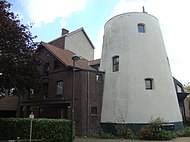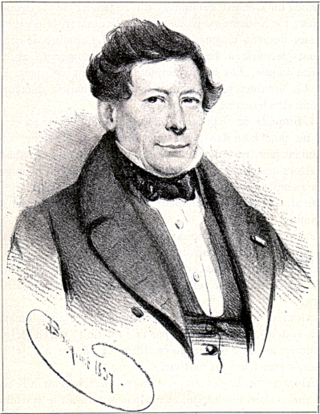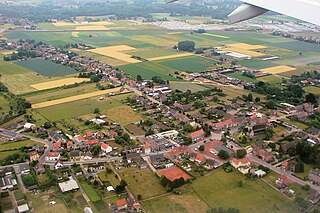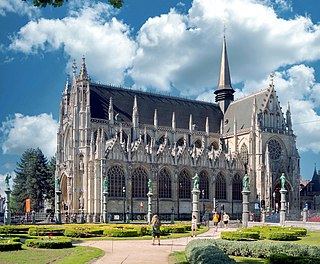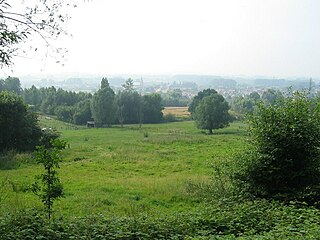- Large farm from the 17th and 18th centuries
- Windmill from the 19th century
- Farmhouse dated from 1628
- Long House with gable roof and two floors of the 18th century
- Gatehouse flanked by outbuildings and farmhouse from the 19th century
- Coat of arms of Kortenberg
Places of interest
de Merode Castle

The de Merode castle is a reconstruction of the court of Montenaken. The court of Montenaken was only about a few hundred meters away from the castle. The de Merode castle was built in the 16th century and contains three separate buildings: the residence, a building for the animals and a building for employees and the stabling of the carriages. When Louise-Brigitte married Filips-Frans de Merode, the castle became property of the de Merode family. The influences of the family de Merode were of great significance among other things because they managed a large part of the forest and the estates (which they still do) and participated in church and administrative policy in the village. On this day the family de Merode still lives in the castle. The domain is regarded as private property, among the surrounding forest.
Gamekeeper's House

The gamekeeper's house lies alongside the cobbled Princes Lane (Prinsendreef) in Everberg and was built around 1770. The house was more familiar as the New Hostel (Nieuwe herbergh). This house was rented. Art historians described it as an 18th-century house in provincial regency style. In the end of the 19th century the house became the gamekeeper's house of de Merode Castle. The latter is the owner of the house as well. The gamekeeper's house is known in Everberg as the previous house of 'Jef van Vinus' or Jozef Meersman, who was the actual gamekeeper. Today this house is uninhabited.
St. Martin's Church

The church of Saint Martin of Tours was originally built in Romanesque style. The lower part of the tower is the proof of that. The church was, as most churches, a place of prayer for the local community. The church was therefore a community church, not an independent church or court church. St. Martin's church can be found in the center of Everberg. In the church itself a relic shrine of Saint Martin has its own place. In the 14th century a Late Gothic choir with Brabant buttresses and the northern transept with the Our Lady Chapel, has been added. During the 17th century, the upper part of the tower was rebuilt. In 1773, plans were made by J.B. De Ronde to enlarge the church, but these were never executed. The church was in a disastrous condition during the 19th century. Countess Louise de Merode, sister-in-law of Count Amaury de Merode, donated 71.000 Belgian francs in 1881 to make a restoration possible. The new church was finished in 1893. The actual construction was executed under supervision of Paul Hankar and Hendrik Beyaert, the architects.
Biest Court

The farmstead, Biest Court (Dutch: Biesthof), is located on the corner of the roads Steenhofstraat and Bankstraat. For years it was the castle farmstead of the de Merode Castle. A 'biest' was a place where grass-like rushes grew, a moist piece of land or puddle. This farmstead was built adjacent to such a biest. Originally, it contained two residences which have been put together in the 14th century. Above the entrance, the number 1647 is mentioned, which refers to the construction year of the farmstead as we know it today. At the end of the 17th century, the Princes de Rubempré got hold of the ownership. During the 19th century, two mayors used to live there and it even was a free school for a certain time. More recently, a number restoration works have been executed. Today the Biest Court continues being a farmstead.
van Grave Court
In 1564, a play house or little castle was located in the Kwikstraat (name of a local road): the van Grave Court (Dutch: Hof van Grave). The van Grave family (or 'de Grez' family) has always been an important noble family, starting during the Middle Ages. Maria-Anna van Grave married Juste-Philibert de Spangen, Baron of Herent. By inheritance, the Counts de Gage and the van der Linden family, Barons d'Hoogvorst, became the rightful owners of the castle. At the end of the 18th century, the building was property of Nicolas Blairon from Frameries in Hainaut. He established a school out of it. In 1886, Jan-Baptist Jossa ‘Tiske de Scheper now settled himself in this homestead. He tended his own sheep, and the sheep of de Merode Castle. The 16th century play house was restorated and was made into a house for two families.

